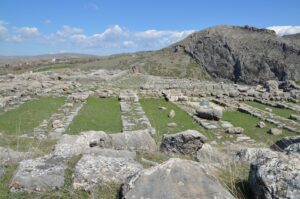By Ann Eberwein
Between 1200 and 1150 BC, cities, regions, and empires across Asia Minor and the Eastern Mediterranean experienced sudden decline and fragmentation in what is termed the Late Bronze Age collapse. Many explanations, both environmental and cultural, have been suggested. Possible environmental causes include volcanic eruption, drought, and pandemic, while possible cultural explanations center on the introduction and spread of ironworking technology and its ramifications. The Hittite Empire was one of the victims of this widespread collapse – the last king, Suppiluliuma II came to the throne in 1207 BC, then in either 1188 or 1177 BC, Egyptian records indicate that the Hittites Empire was destroyed by the “Sea Peoples”. However, new research focused on environmental reconstruction of the period suggests that climate played a key role in the end of the Hittite Empire and possibly others.

Remains of the great temple at Hattusa, the capital of the Hittite Empire. (Photo Credit: Carole Raddato https://www.flickr.com/photos/carolemage/26237539462/)
Gordion, a site on the western boarder of the Hittite Empire was first excavated in 1900; additional excavations took place there from 1950 to 1973 and since 1977 the site has been continuously excavated. The remains of Juniper timbers used in construction at the site have facilitated the creation of the Gordion chronology, a tree-ring chronology that spans over one thousand years from 1775 – 748 BC. Since Juniper rings exhibit reductions in growth during dry years, this sequence provides a detailed reconstruction of the climate around the time of the Hittite collapse. In a new study, researchers from Cornell University, the Cyprus Institute, the University of Georgia, and the University of Wisconsin – La Crosse looked at the entire sequence with a focus on rings with the lowest percentage of annual growth. While they found that low growth rate years occurred frequently, it was uncommon for two or more low growth rate years to occur subsequently. However, from 1210 to 1187 BC between six and eight years in the lowest tree-ring growth category took place including three years in a row, from 1198-1196 BC. This data, which was corroborated through stable isotope analysis of tree ring cellulose, suggests that drought and food shortage must have played a role in the fragmentation of infrastructure in Anatolia and possibly beyond. These findings were published this month in Nature, see the following link for the full article: https://www.nature.com/articles/s41586-022-05693-y.